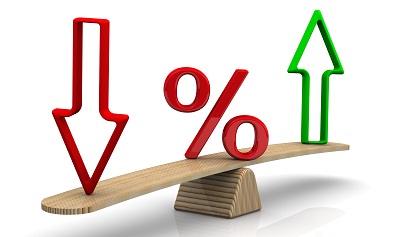Most investors and traders care about future interest rates, but none more than traders of stock index futures, interest rate futures, and currency futures. If you are considering a trade in any of these markets, you must ask yourself, “Do I think interest rates will rise in the future?” If the answer is “yes” then you probably want to avoid long interest rate futures or have some information between prevailing interest rates and yield duration (maturity) from short-term to long-term maturity rates.
The Treasury Yield Curve
In the United States, the Treasury yield curve is the first mover of all domestic interest rates and an influential factor in setting global rates. Interest rates on all other domestic bond categories rise and fall with U.S. Treasury, which are the debt securities issued by the U.S. government. To attract investors or traders, any bond or debt security that contains greater risk than that of a similar Treasury bond must offer a higher yield. For example, the 30-year mortgage rate historically runs 1% to 2% above the yield on 30-year Treasury bonds.
Learn how to trade the 10-year Treasury futures in relation to the economy by downloading your copy of
Interest Rates and the Economy Guide here.
Elements of the Treasury Yield Curve
Nominal Interest Rates
First, it shows nominal interest rates. Inflation will erode the value of future coupon dollars and principal repayments; the real interest rate is the return after deducting inflation. The curve therefore combines anticipated inflation and real interest rates.
Short-Term Interest Rates;
Second, the FOMC directly manipulates only the short-term interest rate at the very start of the curve. The Fed has three policy tools, but their biggest hammer is the Federal Funds Rate which is only a one-day, overnight rate.
Supply & Demand
Third, the rest of the curve is determined by supply and demand in an auction process. The FOMC directly manipulates supply and demand by their bond buying program in the last three years or to the tune of 3 trillion dollars.
Technically, the Treasury yield curve can change in various ways: it can move up or down (a parallel shift), become flatter or steeper (a shift in slope), or become more or less humped in the middle (a change in curvature).
 How the Treasury Yield Curve Moves
How the Treasury Yield Curve Moves
Consider two observations. First, the two rates (long rates vs. short rates) move up and down somewhat together. Therefore, parallel shifts are common. Second, although long rates directionally follow short rates, they tend to lag in magnitude. Specifically, when short rates rise, the spread between 10-year and one-year yields tends to narrow (curve of the spread flattens) and when short rates fall, the spread widens (curve becomes steeper). In particular, the increase in rates from 1977 to 1981 was accompanied by a flattening and inversion of the curve (negative spread). The drop in rates from 1990 to 1993 created a steeper curve in the spread, and the marked drop in rates from March 2000 to the end of 2003 produced a very steep curve by historical standards.
So, what moves the yield curve up or down? Well, let’s admit we can’t do justice to the complex dynamics of capital flows that interact to produce market interest rates. But we can keep in mind that the Treasury yield curve reflects the cost of U.S. government debt and is therefore ultimately a supply-demand phenomenon.
How the Fed Affects the Interest Rate
Supplying More Short-Term Securities
If the Fed wants to increase the federal funds rate, it supplies more short-term securities in open market operations. The increase in the supply of short-term securities restricts the money in circulation since borrowers give money to the Fed. In turn, this decrease in the money supply increases the short-term interest rate because there is less money in circulation (credit) available for borrowers. By increasing the supply of short-term securities, the Fed is “yanking up” the very left end of the curve, and the nearby short-term yields will snap quickly in lockstep.
Interest rates often remain flat during a normal (upward sloping) yield curve. Probably the best explanation for this is that, because a longer bond requires you to endure greater interest rate uncertainty, there is extra yield contained in the ten-year bond. If we look at the yield curve from this point of view, the ten-year yield contains two elements; a prediction of the future short-term rate, plus extra yield (i.e., a risk premium) for the uncertainty. So, we could say that, while a steeply sloping yield curve portends an increase in the short-term rate, a gently upward sloping curve, on the other hand, portends no change in the short-term rate—the upward slope is due only to the extra yield awarded for the uncertainty associated with longer-term bonds.
As Fed watching is a professional sport, it is not enough to wait for an actual change in the Fed Funds rate, as only surprises count. It is important for you, as a bond trader, to try to stay one step ahead of the rate, anticipating rather than observing its changes. Market participants around the globe carefully scrutinize the wording of each Fed announcement and the Fed Governors’ speeches in a vigorous attempt to discern future intentions. The Fed increasingly tips its hand in advance.
When the U.S. government runs a deficit, it borrows money by issuing longer-term Treasury bonds to institutional lenders. The more the government borrows, the more supply of debt it issues. At some point, as the borrowing increases, the U.S. government must increase the interest rate to induce further lending.
Inflation
If we assume that borrowers of U.S. debt expect a given real return, then an increase in expected inflation will increase the normal interest rate (the nominal yield = real yield + inflation). Inflation also explains why short-term rates move more rapidly than long-term rates. When the Fed raises short-term rates, long-term rates should increase to reflect the expectation of higher future short-term rates; however, this increase is mitigated by lower inflation expectations as higher short-term rates also should predict lower inflation (as the Fed sells/supplies more short-term Treasuries, it collects money, and “tightens” the money supply).
Creating Demand for Treasuries
The factors that create demand for Treasuries include economic growth, competitive currencies, and hedging opportunities. Just remember: anything that increases the demand for long-term Treasury bonds puts downward pressure on interest rates (higher demand = higher price = lower yield or interest rates) and less demand for bonds tends to put upward pressure on interest rates. A stronger U.S. economy tends to make corporate (private) debt more attractive than government debt, decreasing demand for U.S. debt and raising rates. A weaker economy, on the other hand, promotes a “flight to quality,” increasing the demand for Treasuries, which creates lower yields. It is sometimes assumed that a strong economy will automatically prompt the Fed to raise short-term rates, but not necessarily. Only when growth translates or “overheats” into higher prices is the Fed likely to raise rates.
Wrapping It All Up
We have covered some of the key traditional factors associated with interest rate movements. On the supply side, monetary policy determines how much government debt and money are supplied into the economy. On the demand side, inflation expectations are the key factor. However, we have also discussed other important influences on interest rates, including: fiscal policy (that is, how much does the government need to borrow?) and other demand-related factors such as economic growth and competitive currencies. We’ve suggested these other factors are constantly shifting, but two important questions to ask are: “Does fiscal policy create too much supply?” and “Will the demand for U.S. denominated debt keep pace in the global market?”
There have been entire volumes of textbooks written on interest rates, this report just scratches the surface. Futures trading is one of those fields where everyone has a different theory on what works and what doesn’t. If we can leave you with one last tip, it is to back test whatever strategy you decide to pursue. Back testing means looking back at several years’ worth of charts to see how a particular futures contract reacts. Each futures market is different and not all respond the same.

